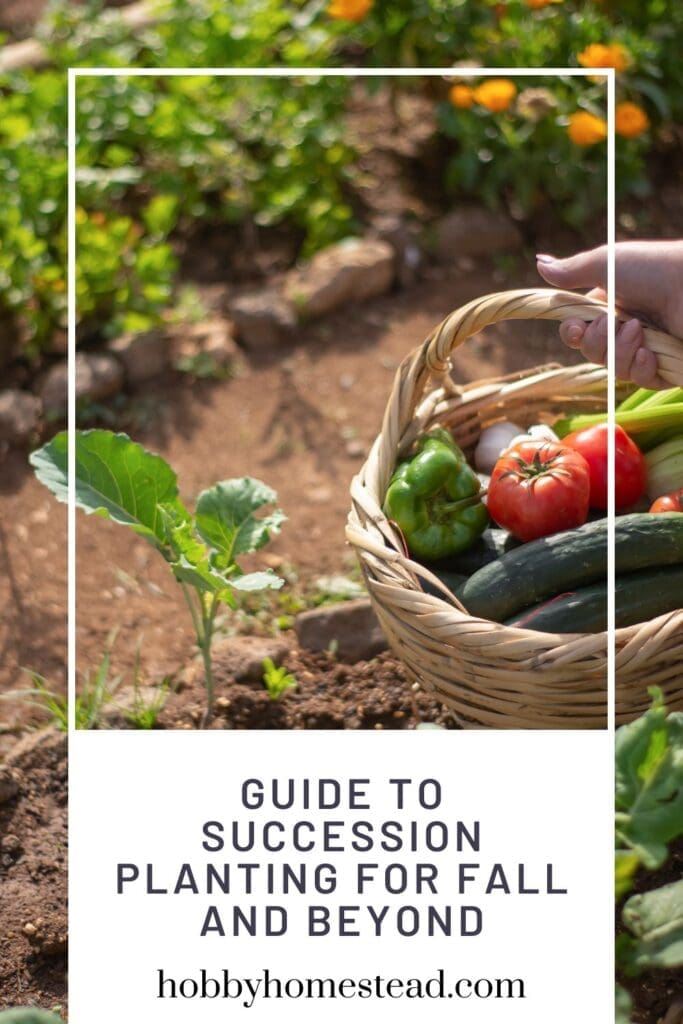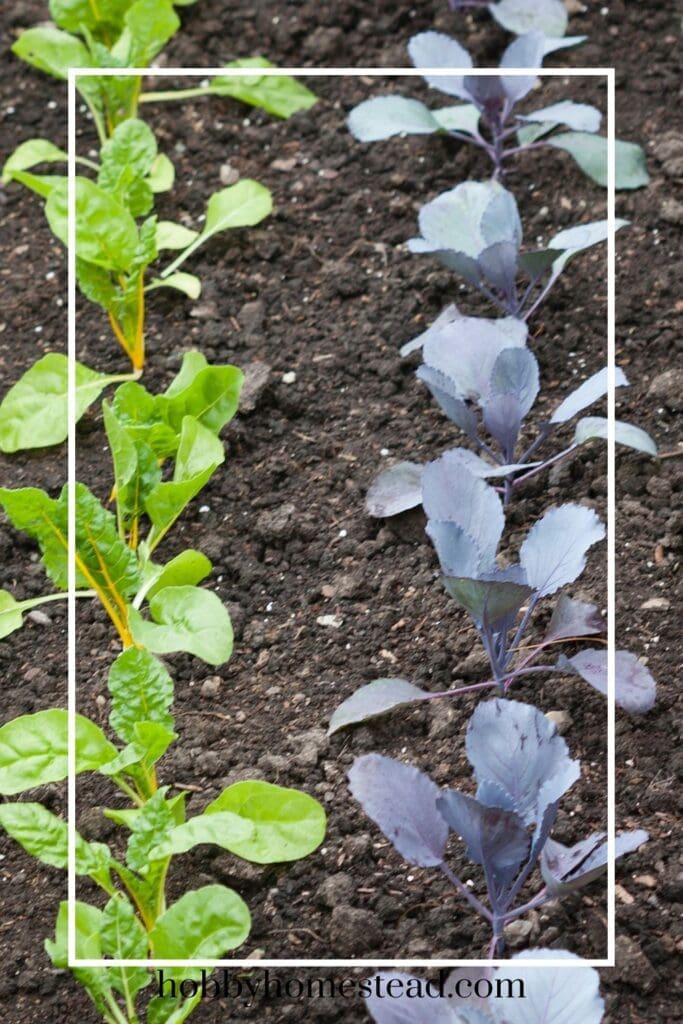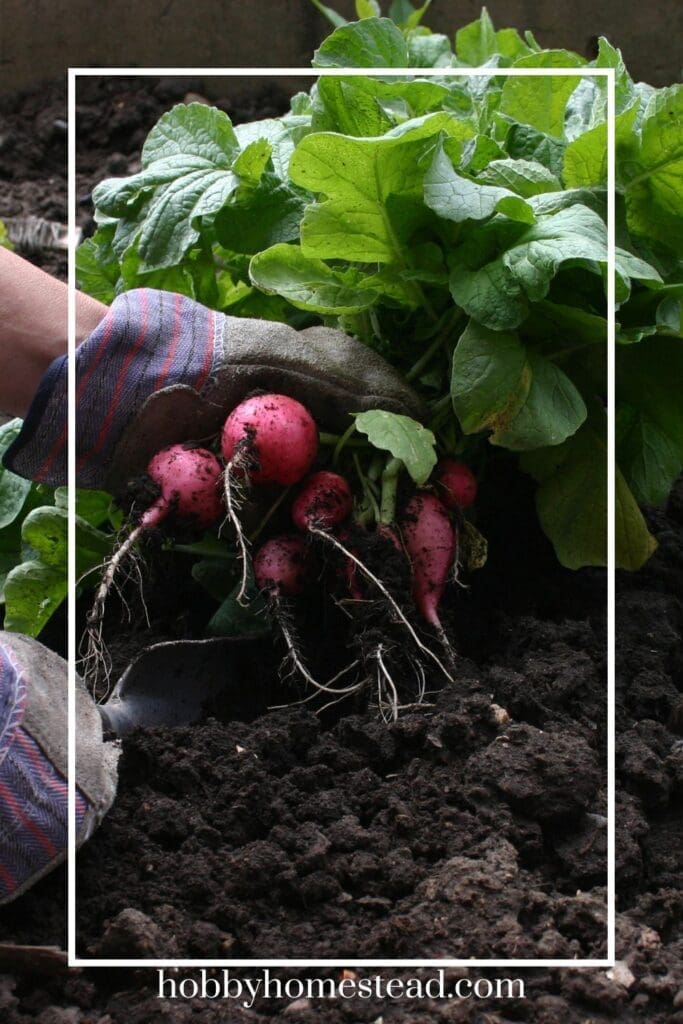With this guide, you can use succession planting for fall and beyond to increase your harvest.
This year, I’ve been watching my daughter plan, plant, and harvest her own garden. It’s been a joy to see her enthusiasm, but it’s also made me realize something: so many of the things I do in the garden without thinking are skills I learned over decades. Things that feel like second nature to me, like succession planting, are brand new to her.
It reminded me that a lot of gardeners, especially those just starting out, don’t know how powerful this simple practice can be.
So today, I’m sharing my best tips for succession planting. What it is, why it’s perfect for homesteaders, and how you can use it to keep your garden productive into fall and beyond.

What Is Succession Planting?
Succession planting is simply staggering your plantings instead of putting everything in the ground at once. Rather than harvesting all your lettuce in one big pile (and watching half of it go limp in the fridge), you plant small batches every couple of weeks.
The result? A steady, manageable harvest that keeps your garden producing instead of sitting empty.
Why Succession Planting Works So Well for Homesteaders
On a homestead, garden space and time are precious. Succession planting:
- Maximizes your growing space. No empty beds between crops.
- Keeps fresh food coming. Perfect for feeding a family year-round.
- Prevents food waste. You only harvest what you need when you need it.
- Fits preserving schedules. Smaller, steady harvests make canning and freezing more manageable.
And in short-season climates like ours here in Wisconsin, this method squeezes every possible day of productivity out of the garden.
Key Principles of Succession Planting
To make succession planting work, you’ll need to plan around three main factors:
- Know your hardiness zone. If you’re not sure what USDA Hardiness Zone you’re in, it’s worth finding out before you start planting. Knowing your zone will tell you two key dates. Your last frost in spring and your first frost in fall. These dates are the bookends of your growing season, and they’ll help you figure out exactly when to start seeds or transplant crops so they have enough time to grow and produce before the weather turns.
- Know your first frost date
In much of Wisconsin, that’s late September to mid-October. This will be your countdown clock. - Pay attention to days to maturity
Short-season crops and cold-hardy varieties are your best friends. - Plan backwards
If a crop takes 45 days to mature and your first frost is in 60 days, you’ve got a planting window. - Think about soil health
Rotate crops so you’re not planting the same family in the same spot back-to-back.

🌾 Succession Planting Strategies
There’s more than one way to make succession planting work:
1. Same Crop, Different Planting Dates
Example: Plant radishes every 10 days for continuous harvests until frost.
2. Different Varieties of the Same Crop
Choose early, mid, and late varieties of lettuce or carrots for a longer season.
3. Follow-One-Crop-with-Another (Relay Planting)
When early peas are done, plant spinach in that bed for fall greens.
If you garden with raised beds, succession planting can be even more efficient. The well-drained soil warms up faster in spring, letting you start earlier, and it’s easier to work between plantings. Some gardeners even divide their raised beds into smaller “mini-beds,” each with its own planting schedule. This not only maximizes space but also helps prevent crops from competing with each other for nutrients and sunlight.
4. Intercropping
Plant quick crops like radishes between slower crops like cabbage. You’ll harvest the radishes before the cabbage needs the space.
5. Overlapping Plantings
Start seedlings for the next crop indoors while your current crop is still growing.
🥕 Best Crops for Late Summer & Fall Succession Planting
In late summer, you’ll want to focus on fast-maturing and cold-hardy crops:
- Fast growers. Radishes (20–30 days), arugula (20–30 days), baby lettuce (25–35 days)
- Cold-hardy greens. Kale (50–60 days), spinach (40–50 days), Swiss chard (50–60 days)
- Quick roots. Beets (50–60 days), turnips (40–60 days)
- Late brassicas. Broccoli (60–70 days), kohlrabi (45–60 days)
Wisconsin Zones
Most of Wisconsin is Zone 4, with a few southern areas in Zone 5.
For Zone 4, your average first frost date is generally mid-to-late September, so your succession planting window is about 2–3 weeks shorter than Zone 5.
For Zone 5, start your last sowings of quick crops 4–6 weeks before first frost, and use row covers for a few extra weeks of harvest.
How to Plan Your Succession Schedule
Here’s a simple way to do it:
- List your crops and note their days to maturity.
- Find your first frost date for your area.
- Count backwards from that date to find your last possible planting date.
- Mark planting intervals on your calendar for repeated sowings.
- Leave time to amend soil with compost between plantings.
Example for lettuce in Zone 5:
- First frost date: October 5
- Days to maturity: 30
- Last planting date: Around September 5
- Plant every 2 weeks starting mid-July for a continuous harvest.

Extending the Season
With the right tools, you can push your harvest well past your frost date:
- Row covers/frost cloths. Add 5–10°F of protection.
- Cold frames or low tunnels. Great for greens and herbs.
- Mulching. Insulates root crops like carrots and beets so they can stay in the ground longer.
- Overwintering. Plant garlic in October for a summer harvest, or spinach in fall for early spring greens.
🚫 Common Mistakes to Avoid
- Planting too late without frost protection.
- Not rotating crops (risking pests and disease).
- Forgetting to replenish nutrients between plantings.
- Planting too much at once and defeating the purpose.
🌿 Quick Reference: Best Crops for Succession Planting (Zone 4 Friendly)
- Radishes. Sow every 7–10 days.
- Arugula & Lettuce. Sow every 10–14 days.
- Bush Beans. Sow every 2 weeks through mid-summer.
- Beets. Sow every 2–3 weeks.
- Cilantro. Sow every 2–3 weeks; best in early spring and late summer.
- Turnips & Kohlrabi. Ideal for late summer sowing.
- Spinach & Swiss Chard. Excellent for fall crops.
- Cucumbers & Summer Squash. Replant as older plants fade.
- Cauliflower, Kale, & Other Brassicas. Thrive in cooler weather.
💡 Tip: Always check the seed packet or supplier’s website for the exact days to maturity and planting recommendations for your specific variety.
Easy Ways to Increase Your Harvest by Planning for Fall and Beyond
Watching my daughter discover succession planting has been a good reminder for me. Some of the most valuable gardening skills aren’t complicated, but they can make a huge difference in how much you harvest.
If you’re looking to get the most out of your garden. Especially here in Wisconsin where our growing window is short. Give succession planting a try. Start with one or two crops and see how it works for you. Before you know it, you’ll be harvesting fresh food right up until the snow flies.


